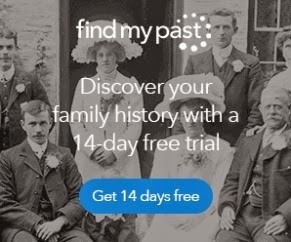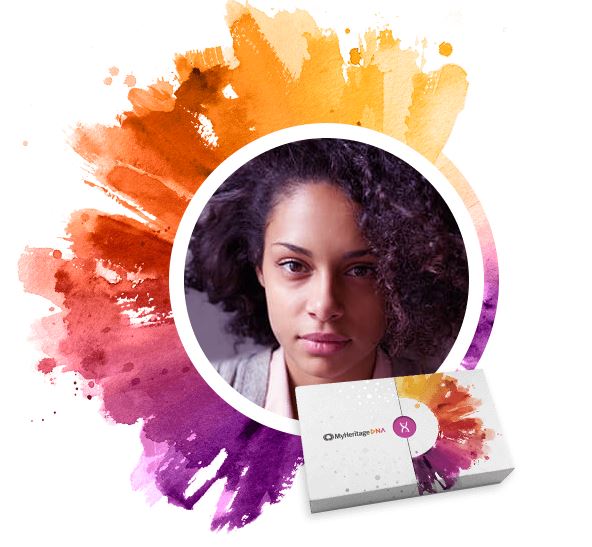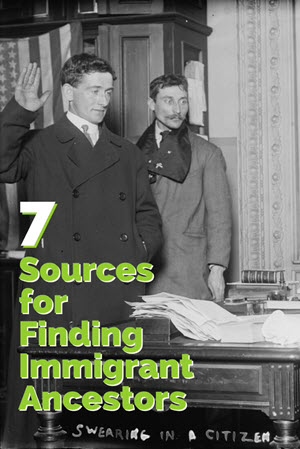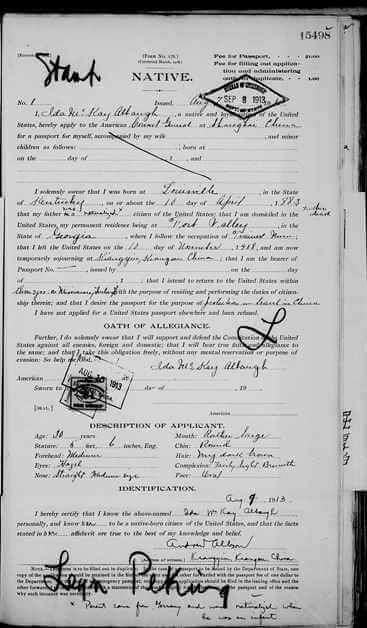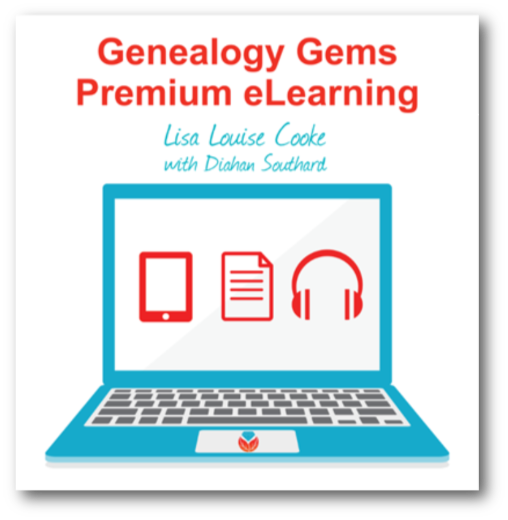Blog


French Genealogy Records and More—Now Free Online!
Nearly 2.5 million French genealogy records are among the free collections now available online at FamilySearch.org. Also: German church records, Dutch civil registrations and 3 free digital archives for researching U.S. ancestors in CT, GA and NJ.
Free French genealogy records
France, Brittany, Church and Civil Records, 1521-1896 is a new collection of more than 2.4 million birth, marriage, and death records from Ille-et-Vilaine and Côtes-d’Armor. It’s now free to search on the Genealogy Giant FamilySearch.org. In addition to knowing the name of the person you’re searching for, the site also recommends you have a good idea of at least one additional piece of information about them, such as a birthplace, birth date or parents’ names, so you can more confidently distinguish your relatives from others with similar names.
Click here for links to resources on reading French-language records—and keep reading for a link to learn more about getting and using your free guest account at FamilySearch.org.
Chile civil registrations
Nearly 360,000 indexed names have been added to Chile, Civil Registration, 1885-1932, a collection of indexed and imaged birth, marriage, death and other records created by civil registration offices in Chile. Some of the 1.6 million record images have been indexed, so you can search for ancestors by name. More names are being added on an ongoing basis, so keep checking back—or browse the records yourself if you know the approximate time and place to find your family’s names in them.
German church records
Another new (and free, as always on FamilySearch.org) collection is 250 years’ worth of German Catholic birth, marriage and death records: Germany, Rhineland, Diocese of Trier, Catholic Church Records, 1704-1957. Important note: the collection description states that “These images are available to view at Family History Centers…If possible, visit your nearest Family History Center to view the images.” Click here to find a Family History Center near you—and contact them to confirm their hours and access to the records you want.
Netherlands civil registration
More than 200,000 free records have been added to an existing FamilySearch collection of over 6 million records, Netherlands, Noord-Holland, Civil Registration, 1811-1950. In addition to births, marriages, and deaths, you’ll also find 10-year indexes, marriage intentions, marriage proclamations, and marriage supplements! According to the collection description, that date range isn’t comprehensive: “The collection covers the years 1811 to 1950, but the exact years vary within each municipality and record type.”
3 free digital archives for researching U.S. ancestors
Connecticut. Connecticut State Library Announces 25 Historic Newspaper Titles to be Digitized. “The Connecticut State Library is pleased to announce that with a third grant from the National Endowment for the Humanities, 25 newspaper titles have been selected to be digitized for the Connecticut Digital Newspaper Project (CDNP), and made freely available online. “
Georgia. The Digital Library of Georgia has announced new digital collections from Spelman College and Morehouse College. Among the digitized resources for these historically black colleges are the Spelman Messenger (1885-2016), “featuring school news, articles by students, creative writings, book reviews, alumni notes and obituaries;” Spelman Catalogs and Bulletins since 1881, Spelman yearbooks (1951-2007) and Morehouse College yearbooks back to 1923. College yearbooks, newspapers and even the annual administrative documents about the degree programs, faculty and campus life, and tuition can give a unique insight into your college-attending forebears.
New Jersey. The Newark Public Library has announced the new Newark Public Library Digital Archive with “over 50 collections and 23,000 items related to African American, Latino, and Newark history.” Documents include genealogically-rich sources such as photographs, city directories, newspapers, and maps. According to the announcement, “Highlights include thousands of photos of Newark Public Schools, the Samuel Berg collection of Newark Street photos, Newark maps and atlases, Newark area newspapers (including the Newark Herald, City News, and La Tribuna!) & so much more!”
Access French genealogy records and others on FamilySearch.org
FamilySearch is the Genealogy Giant that’s always free to use—so everyone should! Our best tip is to create a free guest login on the site so you can maximize your access to all its resources. Click here to read more about how to use that guest login on FamilySearch.org–and more about what kinds of resources you’ll find at your fingertips there. And did we mention that it’s FREE?

About the Author: Sunny Morton
Sunny is a Contributing Editor at Lisa Louise Cooke’s Genealogy Gems; her voice is often heard on the Genealogy Gems Podcast and Premium Podcasts. She’s known for her expertise on the world’s biggest family history websites (she’s the author of Genealogy Giants: Comparing the 4 Major Websites); writing personal and family histories (she also wrote Story of My Life: A Workbook for Preserving Your Legacy); and sharing her favorite reads for the Genealogy Gems Book Club.
Disclosure: This article contains affiliate links and Genealogy Gems will be compensated if you make a purchase after clicking on these links (at no additional cost to you). Thank you for supporting Genealogy Gems!

Genealogy Gems Podcast Episode 216
Genealogy Gems Podcast Episode 216
with Lisa Louise Cooke
In this episode:
- Lisa shares her experiences Down Under in Australia
- Enjoy Lisa’s exclusive RootsTech 2018 interview with Findmypast CEO Tamsin Todd;
- Military Minutes contributor Michael Strauss shines a spotlight on women who have served in the U.S. military;
- Your DNA Guide Diahan Southard introduces the MyHeritage chromosome browser; and
- Genealogy Gems Premium membership gets its biggest boost ever.
NEWS: ROOTSTECH 2018 RECAP
Click here to watch the short RootsTech 2018 official recap video.
NEWS: GENEALOGY GEMS PREMIUM eLEARNING
Update: The Companion Guidebook has been discontinued.
Lisa Louise Cooke uses and recommends RootsMagic family history software. From within RootsMagic, you can search historical records on FamilySearch.org, Findmypast.com and MyHeritage.com.
Keep your family history research, photos, tree software files, videos and all other computer files safely backed up with Backblaze, the official cloud-based computer backup system for Lisa Louise Cooke’s Genealogy Gems. Learn more at https://www.backblaze.com/Lisa.
BONUS CONTENT for Genealogy Gems App Users:
Beginning German Genealogy: Defining “German”
If you’re listening through the Genealogy Gems app, your bonus content for this episode is some get-started-now tips from Legacy Tree Genealogists on tracing your German ancestors. The Genealogy Gems app is FREE in Google Play and is only $2.99 for Windows, iPhone and iPad users.
To learn more about Legacy Tree services and its research team, visit www.legacytree.com. Exclusive Offer for Genealogy Gems readers: Receive $100 off a 20-hour research project using code GGP100. (Offer may expire without notice.)
MILITARY MINUTES: CELEBRATING WOMEN IN U.S. MILITARY HISTORY

Military Minutes with Michael Strauss
Click here to see the full article (and plenty of images!) on the Genealogy Gems website.
INTERVIEW: TAMSIN TODD AND BEN BENNETT, FINDMYPAST.COM
Findmypast.com is the Genealogy Giant best known for its deep, unparalleled historical record content for England, Scotland, Ireland and Wales.
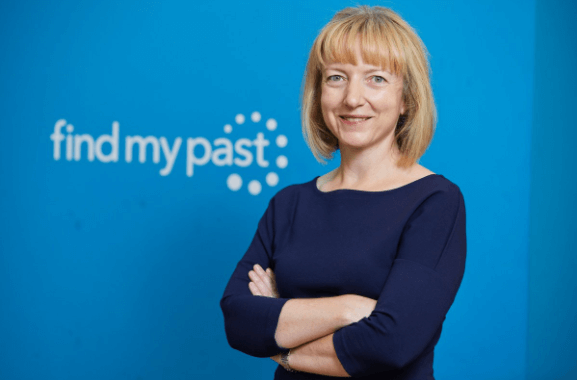
Tamsin Todd is the Chief Executive Officer of Findmypast.com. She “has worked in the travel, retail and technology sectors, and brings with her a track record of leading successful growth businesses. She spent the early part of her career at Amazon and then Microsoft, where she led the introduction of ecommerce and search products into the UK and Europe. This was followed by stints as Head of Ecommerce at Betfair, and Managing Director of TUI-owned Crystal Ski Holidays. She joins Findmypast from Addison Lee, where she was Chief Customer Officer of Europe’s largest car service company. Tamsin lives in London with her family, and is Digital Trustee of the Imperial War Museums.”
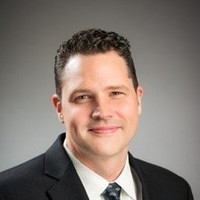
Ben Bennett is Executive Vice President, North America and International at Findmypast.com, “focused on helping families stay connected in the United States and other markets across the globe.”
EPISODE SPONSOR: CASPER MATTRESSES

The original Casper mattress combines multiple, supportive memory foams for a quality sleep surface with the right amounts of both sink and bounce. Breathable design helps you sleep cool and regulates your body temperature throughout the night Delivered right to your door in a small, ‘how do they do that?!’ sized box! Free shipping and returns in the US and Canada.
Exclusive Genealogy Gems offer! Get $50 toward select mattresses by visiting Casper.com/gems and using gems at checkout. (Terms and conditions apply.)
YOUR DNA GUIDE: MYHERITAGE CHROMOSOME BROWSER
Just last year, if you had asked me if I thought anyone could catch AncestryDNA in their race to own the genetic genealogy market, I would have been skeptical. However, it is clear that MyHeritage intends to be a contender, and they are quickly ramping up their efforts to gain market share and your confidence.
MyHeritage began 2018 by making a much-needed change to their DNA matching algorithm, which had some errors in it. They were able to adjust it, and now it is humming right along, telling our second cousins from our fourth. Another development, launched in February, is the addition of a Chromosome Browser.
THE NEW MYHERITAGE DNA CHROMOSOME BROWSER
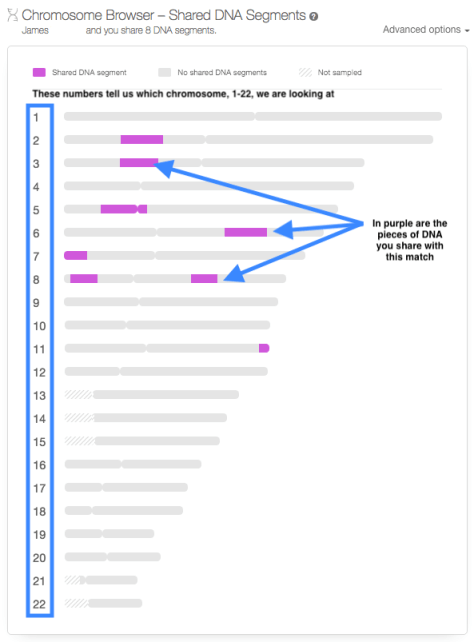
Much like you would browse the library shelves for the perfect book, or browse through the sale rack for a great bargain, you can use a Chromosome Browser to look through your chromosomes for the pieces of DNA you share with your genetic cousins.
Chromosome Browsers can be everything from a fun way to review your genetic genealogy results, to a tool to assist in determining how you are related to someone else. Let’s go over three tips to help you make use of this new tool.
NAVIGATING TO THE CHROMOSOME BROWSER
There are actually two different kinds of Chromosome Browsers in MyHeritage: one to view only the segments you share with one match (the One-to-One Browser), and a browser where you can see the segments shared with multiple matches (the One-to-Many Browser).
To get to the One-to-One Browser, head over to your match page and find a cousin for whom you would like to see your shared DNA segments. Click on Review DNA Match, then scroll down past all the individual match information, past the Shared Matches and Shared Ethnicities until you see the Chromosome Browser.
USING THE ONE-TO-MANY CHROMOSOME BROWSER
To find the One-to-Many Chromosome Browser, you can use the main DNA navigation menu at the top of the MyHeritage homepage. Click on DNA, then on Chromosome Browser, as shown below.
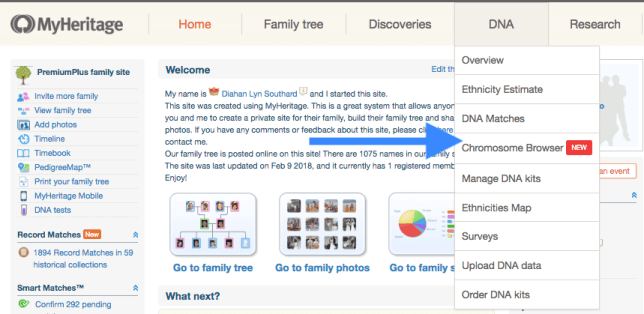
In the One-to-Many Chromosome Browser you can compare yourself, or any account you manage, to anyone else in your match page. To choose a match to evaluate, just click on their name and they will be added to the queue at the top, as shown here.
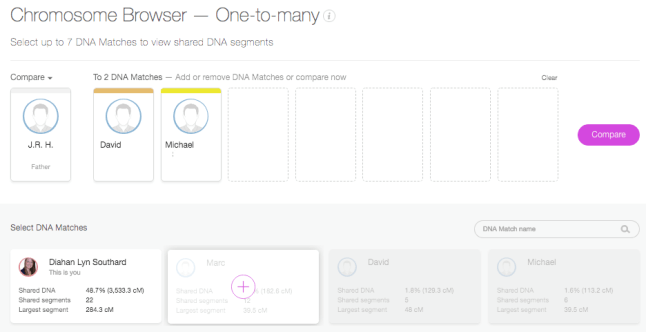
Clicking on Compare will then allow you to see the actual segments you share with each person:
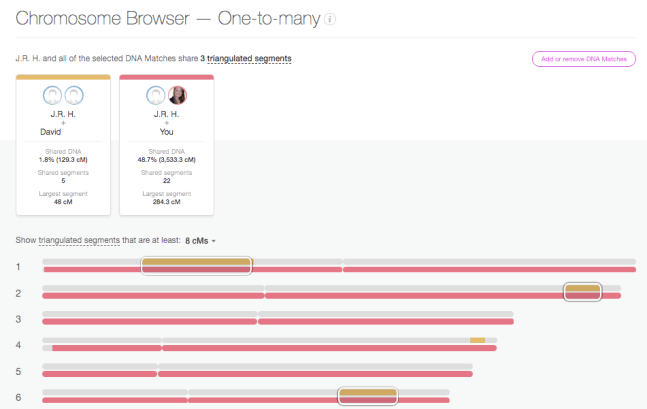
In this One-To-Many view, each individual match gets their own line for each chromosome. Since we have added 7 people to the Chromosome Browser, there are seven lines next to each chromosome number. Each match not only gets their own line, but also their own color. So you can easily match up the lines on the chromosome to the match that shares that piece of DNA with you. For the majority of people the majority of the time, these Chromosome Browsers are just another fun way to visualize the connection you have with your DNA match. In the end, it doesn’t matter where you are sharing on the chromosome, just how much DNA you are sharing. You can obtain that information from your main match page and never look at this Chromosome Browser image, and still make fantastic genetic genealogy discoveries.
THE TRIANGULATION TOOL
Another feature of the Chromosome Browser on MyHeritage is the Triangulation tool. To understand how this works, you first need to understand that you actually have two copies of each chromosome. Two copies of chromosome 1, two copies of chromosome 2, etc. One copy is from mom, and the other from dad. However, in the Chromosome Browser image, you see only one line for yourself (in grey). Therefore, when you see someone matching you on chromosome 14, for example, you don’t know if that person is matching you on the chromosome 14 you got from your mom, or the chromosome 14 you got from your dad.
Likewise, if you see two people whose shared piece with you looks to be in the same location on the same chromosome, you can’t tell if they are both sharing on the same copy of that chromosome, or if one match is related to your dad’s family, and the other match is related to your mom’s family. However, this is what the Triangulation tool does for us. It tells us if two (or three or four, etc.) matches are sharing on the same copy of the same chromosome. Be careful when you use this tool, though. Many erroneously assume that when they see a segment shared between multiple people, that indicates the presence of a recent common ancestor for all of those people. However, that is not always the case.
MyHeritage.com is the place to make connections with relatives overseas, particularly with those who may still live in your ancestral homeland. Click here to see what MyHeritage can do for you: it’s free to get started.
Ready to start exploring what the MyHeritage DNA chromosome browser may tell you about your family history? You have two options. Click here to upload your autosomal DNA test results from another company to MyHeritage for FREE. Or click here to order a MyHeritage DNA test kit. Either way, you can start using all the great tools at MyHeritage DNA!
PROFILE AMERICA: FORD LAUNCHES ASSEMBLY LINE
PRODUCTION CREDITS:
Lisa Louise Cooke, Host and Producer
Sunny Morton, Editor
Diahan Southard, Your DNA Guide, Content Contributor
Michael Strauss, Military Minutes Content Contributor
Hannah Fullerton, Production Assistant
Lacey Cooke, Service Manager
Disclosure: This page contains affiliate links and Genealogy Gems will be compensated if you make a purchase after clicking on these links (at no additional cost to you). Thank you for supporting this free podcast and blog!
Subscribe to the Genealogy Gems newsletter to receive a free weekly e-mail newsletter, with tips, inspiration and money-saving deals.

Resources
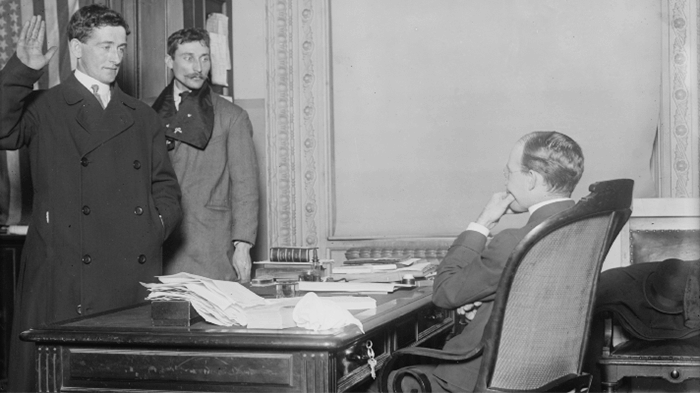
7 Sources for Finding Immigrant Ancestors
If you have immigrant ancestors who arrived in the U.S in the 1900s, these 7 sources can help you track their journey—perhaps even to that overseas hometown, so crucial to your genealogy success!
(Thanks to Legacy Tree Genealogists for providing us with this guest blog post. Learn more about them below.)
Do you have an ancestor who came to the United States in the 20th century? If so, you’re in luck, as there are a variety of resources available to help you learn about their journey to the United States and where they came from. The biggest challenge in tracing the ancestry of immigrants is that you must first identify their exact hometown (not just country or region) before you can locate records in their home country. Luckily, there were a variety of records created when an immigrant came to the United States in the 20th century that can provide helpful clues for finding their exact place of birth.
7 record types for finding 20th-century immigrant ancestors
Naturalization and alien registration records
Naturalization records were created as part of an application for citizenship, while alien registration records were created for any non-citizens living in the United States. Both sets of records can contain a wealth of information about immigrants, including their hometown, family members, identifying information such as birthdates or physical descriptions, and when and how they traveled to the United States.
After 1906, there were three parts to naturalization records: a declaration of intention (sometimes called 1st papers), a petition for naturalization (2nd papers) and the naturalization certificate given if citizenship was granted. The declaration of intention is the most useful for genealogical purposes, as immigrants were required to state their birth dates, often family members’/spouses’ birth dates, and usually their hometowns.
Naturalization records were kept by the various federal, state, and county courts, and many have been digitized on various genealogy websites. Naturalization records can be found at the National Archives, FamilySearch.org, and Ancestry.com. After the Alien Registration Act of 1940, all immigrants to the United States were required to register and be fingerprinted. Alien Files began to be kept in 1944 and are now held by the National Archives.
(Editor’s note: Genealogy Gems Premium e-Learning members can also learn about World War I-era enemy alien affidavits, required for all non-naturalized U.S. residents, in the Genealogy Gems Premium Podcast episode #146.)
You can narrow down the time period your immigrant ancestor naturalized by checking various censuses which asked citizenship information (1900, 1910, 1920 and 1930). The 1920 census is particularly helpful as it asked the year of naturalization in addition to the year of arrival. There were three codes recorded in these columns: PA (has submitted papers), NA (naturalized) or AL (alien—never applied to become a citizen). Knowing where they were living at the time of naturalization will help you narrow down which court they may have used.
Keep in mind that until 1922, married women (and their children) were automatically given the citizenship of the husband (if he was a citizen, so was the wife; if a woman married a non-citizen she lost their citizenship until he became a naturalized citizen). Prior to 1922 wives did not need to apply separately, so there will almost never be naturalization papers for married women—you’ll need to look under their husband’s name.
Passenger lists
Passenger lists were created to document the travels of immigrants and are organized by ship. Some list the travelers’ hometown and their closest living relatives there, which can be extremely useful in linking families. Keep in mind that this will usually be the immigrants’ most recent place of residence (which is not always the birthplace).
When searching passenger lists, be sure to check both emigration and immigration records. Passenger lists created at the point of departure and the port of entry and may give slightly different information. For example, the Hamburg Passenger Lists for Germany recorded those leaving, while the New York Passenger Lists give arrivals—you may find your immigrant on both.
United States passenger lists will often also state the relative they are going to meet who is already in the United States—this can help in differentiating people of the same name. (Another bonus for Premium eLearning members: learn about emigration records in Premium Podcast episode #135.)
The port they came from or arrived in can also give clues as to where they were from in the Old Country—people generally immigrated and settled with others who were from the same place. While many of passenger lists have been digitized on the big genealogy websites such as FindMyPast.com, Ancestry.com, and FamilySearch, do not overlook smaller collections like the Immigrant Ancestors Project, which focuses on other emigration records from smaller ports.
Canada Border Crossings
If you are not finding your immigrant in United States passenger lists, see if they came through Canada. Many immigrants arrived in Canada first and then crossed the border to the United States. Keep in mind that only immigrants who came through ports or trains were recorded—if they crossed by horse or car they will not be included in the records. These records vary but often include the name of the immigrant, who they were going to join, their last residence and family member there, their place of birth, and any previous visits to the United States (4). Both Ancestry.com and the free FamilySearch.org have digitized records border crossings to the U.S. from Canada beginning in 1895 (FamilySearch’s go to 1956 and Ancestry.com’s to 1960).
Passport applications
Did your immigrant ancestor ever apply for a passport? Many immigrants went back to visit family in their home country for a few months or even years, before returning back to the United States If they had already become a citizen, they may have applied for a passport to travel. These records can give you a wealth of information about the person who applied but also sometimes their parents.
If you are stuck on an immigrant, look for records about their children—they may provide valuable clues. For example, my great-great aunt applied for a passport in 1918 to be a missionary in China, and she stated that her father had been brought over as an infant from Germany with his parents, who had then naturalized. However, on her passport renewal she stated he was born in Baltimore, so his exact birthplace is still a mystery. However, the passport provided an important clue—now I know to look in the area around Baltimore for naturalization records that could mention his parents. (Click here to read a Genealogy Gem listener’s success story using passport applications and more information on finding them.)
Church records
Many immigrants attended church in their new town along with others from their homeland. Records created at the church, such as baptisms, marriages, and burials, can often provide information about where they came from. Some of these churches even conducted services in the native language of their congregants (i.e. German). These records can be challenging to locate as many of them are still kept by the local churches and have not yet been digitized by the major genealogy websites, but they are well worth it. Try contacting the local church to see if they still have records or know where the records are now. It’s polite to offer a small compensation for their time. Click here to find a list of articles on this website about all different kinds of church records.
Foreign language newspapers
A little-known fact about immigration is that many immigrant communities published local newspapers in the language of their homeland in their new community as a way to stay connected. These newspapers often include birth, marriage and death announcements relevant to the community of immigrants and may list your ancestor. Many of these newspapers are listed on the Library of Congress website Chronicling America, covered in detail in an exclusive interview in the Genealogy Gems Premium Podcast episode #158. (If you’re not a Premium member, consider checking out Lisa Louise Cooke’s book How to Find Your Family History in Newspapers or click here to read articles relating to newspaper research on our blog.
For more help finding immigrant ancestors….
Thanks to Mckenna Cooper, a researcher for Legacy Tree Genealogists, for writing this guest article. Legacy Tree Genealogists is a worldwide genealogy research firm with extensive expertise in breaking through genealogy brick walls. To learn more about Legacy Tree services and its research team, visit www.legacytree.com. Exclusive Offer for Genealogy Gems readers: Receive $100 off a 20-hour research project using code GGP100! (This offer may expire without notice.)
If you prefer the DIY approach to finding your immigrant ancestors rather than hiring assistance, Genealogy Gems is here for you! We gave you lots of links above to further reading. You may have noticed that Genealogy Gems Premium eLearning provides even more resources for you–why not consider whether this may be a good option for you?
Disclosure: This article contains affiliate links and Genealogy Gems will be compensated if you make a purchase after clicking on these links (at no additional cost to you). Thank you for supporting Genealogy Gems!







